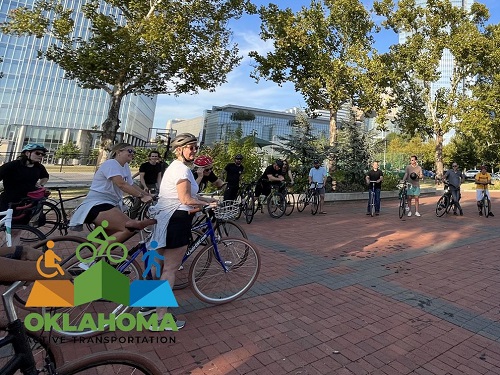The Oklahoma Department of Transportation is working on its first-ever active transportation plan – a policy toolkit that can be used internally and by Oklahoma counties and towns as engineers and designers look to develop more people-friendly infrastructure.
[Above image by the Oklahoma DOT]
The plan will address walking, biking, “wheelchairs and mobility scooters, pedal and electric scooters, electric bikes, skateboards, and other similar wheeled vehicles,” according to a website developed by the agency that details the plan’s contents.
The finished product will be more of a policy guide than a rule book, said Shelby Templin, an Oklahoma DOT certified planner who is heading up the plan’s development.
“We’re hoping this will guide our engineers and designers, in-house, as well as provide a starting-off point for smaller communities that may not have the resources,” she said. “It also will give the multi-modal group more of a leg to stand on for project development.”
The agency said its Active Transportation Plan is expected to be completed this summer and opened to a 30-day public comment period. In the fall, Oklahoma DOT expects to submit the plan to the Oklahoma Transportation Commission for approval.
Right now, an Oklahoma DOT consultant is analyzing about 1,000 citizen surveys and results from 10 online workshops, alongside the development of “scenario planning” sessions by the agency – sessions that examine situations involving active transportation in order to determine which infrastructure tools work best.
The rise in pedestrian deaths across the country is also giving some added urgency to developing the plan, Templin pointed out. “We basically create intersections or hot spots where, theoretically, we’d be having an issue with crashes or a high number of pedestrians,” she explained.
The department also is researching and reviewing best practices from other states that already have Active Transportation Plans, as Oklahoma DOT is one of a handful of state departments of transportation that do not have such a plan, Templin said.
[Editor’s note: The Washington State Department of Transportation unveiled a formal Active Transportation Plan in December 2021 – which won the 2022 America’s Transportation Awards contest’s “People’s Choice Award” – with the Kansas Department of Transportation developing one in December 2020 and the Ohio Department of Transportation launching one in July 2019.]
The Active Transportation Plan development process, which kicked off in the fall of 2022, might not have happened except for an assumption Oklahoma DOT made about what would be in the $1.2 trillion Infrastructure Investment and Jobs Act or IIJA enacted in November 2021.
“We thought that all states would have to have an Active Transportation Plan, so the conversation here was already starting,” Templin said. When the IIJA did not include an Active Transportation Plan mandate, “we were already planning for it, so we decided to do it now because we didn’t want to have our hand forced into it.”
The impact of the COVID-19 pandemic the transportation habits of state residents became another “deciding factor” in the development of an active mobility strategy, she noted. The pandemic “shifted people’s minds to realize that not everyone has to drive a car,” said Templin. “There are other options.”
Like every state, Oklahoma has its own transportation issues that don’t fit neatly in a one-size-fits-all template, so those situations must be incorporated into the plan.
“I think in Oklahoma, it’s pretty common to live a longer distance from where people work,” Templin said. “So, it’s not always going to be about commuting – you look for more realistic opportunities. I live 35 miles from work, so I’ll never walk or bike to work, but I live a half-mile from a 7-11.”


